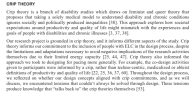Dolphin
Senior Member (Voting Rights)
Lull: Designing Crip Pacing Technologies for Rest
Authors: Sarah Homewood, Nantia Koulidou, Claudia A Hinkle, Irene Kaklopoulou, Harvey BewleyAuthors Info & Claims
DIS '25: Proceedings of the 2025 ACM Designing Interactive Systems Conference
Pages 3082 - 3097
https://doi.org/10.1145/3715336.3735419
Published: 04 July 2025
Abstract
Energy limiting conditions (ELC), such as long COVID and ME/CFS, require the careful monitoring and pacing of activity and rest to avoid over-exertion.Commercially available fitness tracking technologies are currently being “misused” to manage these conditions.
Based on co-design research with people with ELC, we conducted a research-through-design process to ideate upon what ELC pacing technologies could be.
Our ongoing design process is informed by crip theories that highlight the social and political, rather than medical, aspects of disability and chronic conditions.
In an attempt to offer non-medicalising pacing technologies, we explored integrating bronze casting as a jewelry making technique within the prototyping process.
We also explore how we can present quantitative pacing data gathered from wearable sensors through felt vibrations on the body in a way that can be therapeutic and allow for the user to calibrate the quantitative data with their own felt sense of fatigue.

